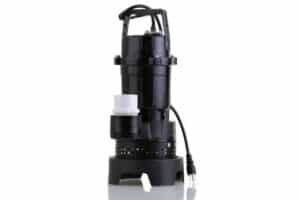
A sump pump is the kind of household device that is practically worth its weight in gold. Even if you only use it once, a sump pump will spare you a tremendous amount of hassle and grief. Learn all about this very handy appliance — what it is, how it works, and why you need one.
What Is A Sump Pump And Sump Pit?

The definition of a sump pump is an electrically powered pump designed for basement flood prevention. It accomplishes this purpose by pumping the excess water out of a sump pit. The pump may be manufactured from plastic, steel, or cast iron. Cast iron is the sturdiest material, with the added advantage of keeping the motor cool.
A sump pit is a hole cut in the floor of your basement or crawlspace to collect groundwater. This pit is usually positioned in a corner and should be at least 60 cm in diameter by 60-90 cm deep.
How Does A Sump Pump Work?
The sump pump, once it’s been connected to an electrical outlet (no need for special wiring!), will monitor the water level in your sump pit using a float activator or pressure sensor.
When the water rises abnormally high (most commonly during heavy springtime precipitation), the pump will automatically switch on. As it pumps the excess water out through a discharge pipe, the liquid is channelled to a storm drain, ditch, or your lawn… safely away from your home’s foundation. A check valve between the pipe and your pump prevents any water from flowing back into the pit.
Some sump pumps are equipped with filters, although the pump-action may be hindered if these get clogged. A Wi-Fi sump pump will alert you of flooding in real-time.
Why Do I Need A Sump Pump?
A sump pump is vital to protect your basement against floods caused by rising groundwater. Calgary tends to experience heavy amounts of rain and melting snow during our spring thaw, with flooding as a consequence. A flooded basement has two disastrous effects on your home:
1) the short-term problem of how to get rid of huge quantities of water
2) the long-term devastating water damage in the form of rotted floors, rusted appliances, mould, insect infestation, and possible erosion of the foundation over time.
You especially need a sump pump if you’ve had the experience of basement flooding in the past. The “micro-geography” of your yard might make you more vulnerable. Poor drainage, a plot that is relatively flat or below water table level, and ground sloping toward your foundation all create the conditions for a flood-prone property.
A sump pump is also a must when you have invested in a finished basement. Unfortunately, a flood could destroy your investment within a few hours — unless you have the protection of a sump pump.
Last but not least, sump pump installation may be a requirement of your homeowners’ insurance policy.
Pedestal Vs. Submersible Sump Pump
Pedestal sump pumps, which are located above ground and utilize an intake pipe, are simpler to install, maintain, and replace. They are long-lasting and inexpensive. However, their small motors (normally only 1/3 HP) overheat easily.
Submersible sump pumps are installed below ground in the sump pit itself. With a more powerful motor of ½ to 1 HP (which is kept cool by the surrounding water), Quieter can cope with solids like gravel, sludge, and waste. A submersible does take up more room in the sump pit, so it may not be suitable for a pitless than 60 centimetres in diameter.
Do I Need A Battery Backup For My Sump Pump?
It is wise to back up your primary sump pump in case of an electrical power outage — as is all too common during storms. An additional pump with a heavy-duty rechargeable battery will provide up to 30 hours of protection when the grid is down.
How Long Do Sump Pumps Last?
A pedestal will last from 25-30 years, while a submersible will last 5-15.
For either type, basic maintenance helps to extend its life. Oil moving parts once a year as specified by the manufacturer. Clean the filter trap (if any) 3 to 4 times a year.
In addition, testing the pump Is important to ensure it won’t fail in an emergency. Just pour a few buckets of water into the pit to make sure the pump kicks in. Not sure whether your sump pump is working as it should? Ask a plumber for a professional inspection.
Knight Is The Address For Expert Sump Pump Service
Are you ready to protect your home against basement flooding? Contact our Calgary plumbing team for reliable sump pump service, including repair, tune-up, and installation.


